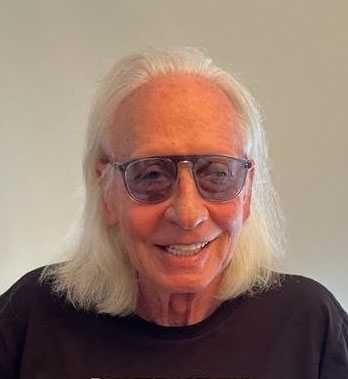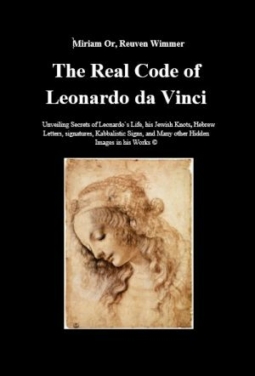This book aims at revealing the connection between Leonardo, Judaism, and Kabbalah. This link is disclosed by analyzing what can be considered his Sacred Geometry Studies (exemplified in the Vitruvian Man), his artistic techniques involving the use of light, and what we believe to be his hidden signature: the use of the decorative pattern of knots, and Solomon’s Knot in particular. Together with the countless Hebrew letters hidden in his paintings, drawings, and notebooks, these tools were combined for the first time to reveal the real code of Leo-nardo da Vinci.
על ראובן וימר

ראובן וימר נולד בחיפה ב 1937, גדל והתחנך בקיבוץ מזרע ושירת בחטיבת גולני. אחרי גמר השירות עזב את הקיבוץ ועבר ללמוד בירושלים ואחרי כן עבר להתגורר בתל אביב. בשנת 1963 החל לעבוד בתחום הפרסום: תחילה במשרד בינג-ליניאל, אחרי כן בפרסום דחף ולבסוף ... עוד >>
The Real Code of Leonardo da Vinci
מאת: ראובן וימר, מרים אור
הוצאה: הוצאה עצמית | מאי 2022 | 150 עמ'
37.00 ₪
מקט: 001-4140-005
Introduction
Five centuries have passed since the time of Leonardo, the most prominent universal genius in the history of human culture. Countless books, essays, research studies, and novels have been written about him, his life, and his works. However, many essential secrets of his life and his tremendous work have not been solved yet.
Despite all the research about Leonardo, many facts about his life remain unclear. His mother’s identity, for example, has been a matter of discussion among many scholars since the documents of Leonardo’s era lack a precise statement of his mother’s name and origin. Scholars have tried to solve this mystery, but their explanations were not enough for us. There had to be something more profound, something at the base of almost everything that Leonardo created during his lifetime. Therefore, we decided to do what needed to be done for any research: we followed the river of Leonardo’s life to its source and found its propelling force. More precisely, we found a combination of two significant, intertwined sources.
It all starts with Caterina, Leonardo’s mother: research was conducted on her, but all the scholars missed the key to her identity and, therefore, Leonardo’s: she was Jewish. Leonardo’s hidden Jewish faith is tightly connected to his love for his mother, Caterina, which was expressed throughout his artistic production.
This book aims at revealing the connection between Leonardo, Judaism, and Kabbalah. This link is disclosed by analyzing what can be considered his Sacred Geometry Studies (exemplified in the Vitruvian Man), his artistic techniques involving the use of light, and what we believe to be his hidden signature: the use of the decorative pattern of knots, and Solomon’s Knot in particular. Together with the countless Hebrew letters hidden in his paintings, drawings, and notebooks, these tools were combined for the first time to reveal the real code of Leonardo da Vinci.
Writing a book about Leonardo da Vinci is problematic for several reasons. First of all, in recent years, many books tried to reveal something new about this Renaissance Genius. The acclaimed biography of Leonardo da Vinci by Walter Isaacson was published in 2017, Young Leonardo, by Jean-Pierre Isbouts and Christopher Heath-Brown. It is not easy to emerge in such a crowded publishing industry, but we kept working with one dominant idea: our book expresses something new and unexpected.
The second challenge posed by this enterprise is that the written sources we have from the time of Leonardo are fragmented and often contradict one another. Matteo Bandello witnessed the artist working on The Last Supper in 1497 and famously described his method in the Novella LVIII. Others, like Giorgio Vasari, wrote about Leonardo after his death by collecting anecdotes and accounts of his life. However, the different editions of Vasari’s Vite present remarkable discrepancies. Of course, we have records from municipal and clerical archives, like the precious tax return from Ser Piero da Vinci, which gives us Leonardo’s age and residence at the time. We decided to combine and compare the different witnesses to let the truth emerge from their voices.
Another critical point in making this book was that we would inevitably have to confront the massive volume of past research. Scholars have been working on Leonardo da Vinci for the past five centuries. In this book, we acknowledge the extraordinary efforts made in the past, but with a necessary clarification: in our opinion, the previous research has missed the real truth about Leonardo.
The final challenge in the making of this book was Leonardo himself. It is no easy task to grasp the mind of a genius who excelled in so many fields of human knowledge. We decided to take an unconventional approach to this problem: trying to think like Leonardo. Much like his geometrical solids, his studies were multifaceted, combining disciplines in what seemed like a random fashion. His quest for knowledge proceeded by leaps from topic to topic, building new theories on the ones that he had developed a moment before. In an attempt to emulate the Renaissance genius, we decided to inaugurate a journey through multiple disciplines believing that, in the end, everything will concur to exhibit the “Real Code of da Vinci” hidden in many of his works.
In this study, we perform a close observation of Leonardo’s paintings and drawings, including the Mona Lisa, the Last Supper, the wall decoration of the Sala delle Asse in the Castello Sforzesco in Milan, the Vitruvian Man, the drawings of the Flower of Life from Codex Atlanticus, and the actual figure of St. John the Baptist.
From the beginning of our research work, throughout the writing of this book, one question troubled our minds: how did it happen that all scholars and experts ignored it for over five hundred years? So, many vital details about Leonardo’s life and many informational clues within his works? Moreover, some of his famous works were given names and misinterpretations, accepted as truth and tradition. In this book, we will hopefully rectify the historical wrongs done to the memory of Leonardo Da Vinci and the understanding of the works of the “Prominent Universal Genius in the History of Human Culture”.
היו הראשונים לכתוב תגובה למוצר: “The Real Code of Leonardo da Vinci”
יש להתחבר למערכת כדי לכתוב תגובה.


אין עדיין תגובות